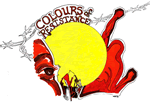Our Own Traditions: anti-authoritarianism in our histories of struggle
This essay appears in Post Colonial Anarchism: Essays on race, repression and culture in communities of color 1999-2004. Access the complete book here
Although many non-white anti-authoritarian traditions never self-identified as anarchist (many were in existence before the word was invented), their social practices and formations demonstrate to us the rich history out of which our own movement comes. There’s no need to impose the term anarchist on descriptions of the history of non-white societies and their struggles against authority and capital to validate our own identification with the term. The history of resistance against illegitimate authority by people of color speaks for itself.
But the problem of tracing and remembering the whole anti-authoritarian tradition does turn on the axis of language and the power to name and exclude through naming. If the substance of anarchism is communal economics, mutual aid, local autonomy and the free federation of communities, then the obvious first place to look at is the continent of Africa. Long before the Paris commune or the Spanish Civil War, African tribes and clans were practicing self-sustaining modes of living that did not require political authority or static structures of social hierarchy.
The Igbo tribe, which settled in the Awka and Orlu areas of West/ Central Africa in what is now Nigeria arranged “‘village’ political units without kings or chiefs ruling over them or administering their affairs.” (Sam Mbah and I.E. Igariwey, African Anarchism: The History of a Movement See Sharp Press Az. 1997 P.35) The fact that Igboland was a large scale society (at one point over 4 million organized into 2000 separate villages) demonstrates the capacity of whole societies to organize themselves along autonomous and communal principals successfully. (John Gunther, Inside Africa Harper and Brothers NY. 1953 P. 760.) “Igbo enwegh eze” “we have no kings” is a central creed of the Igbo. Other African tribes with anti-authoritarian traditions include the Shona of modern day Zimbabwe, the Mano of modern day Ivory Coast and the Kusaasi of Ghana. These tribes and clans along with numerous indigenous tribes in the Americas including the Hopi, Adena, and the Zuni, constitute real examples of stateless social formations that existed long before European political theorists discovered the horrors of the nation-state and labeled the resistance to them anarchist.
In the history of anarchism the above tribes and clans are not mentioned much. Instead we’re invited to study the intellectual progression of the social ideal from William Godwin’s Political Justice to Murry Bookchin’s Post Scarcity Anarchism and a handful of losing confrontations between the forces of state hegemony and anti- authoritarians. People of color who self-identify as anarchist are caught in strange place. How do we reconcile with the term anarchist when its history excludes the explicitly anti-authoritarian struggles of Kikuyus in Kenya against the English Empire’s unsuccessful attempts to impose centralized government structures on a stateless people, or the anti-emperor traditions in various Asian societies that challenged modern 20th century political structures that sought to impose central rule on villages that had been self governing for thousands of years.
An obvious place to begin the reconciliation is with writing the history and doing the public education. Frank Fernandez’s Cuban Anarchism: the History of a Movement published in 2001 traces the resistance to both the U.S. puppet regimes of the first part of the 20th century and the Castro dictatorship up to the present. Black Rose Books has published Land and Liberty: Anarchist Influences in the Mexican Revolution by the late Ricardo Flores Magon. In it the author details the struggles of Emiliano Zapata and the development of the “village anarchist” movement within the context of the Mexican civil war of the 1910’s. Y. Mihara’s 1993 piece “On the Present Situation of Anarchism in Japan” in Anarchist Studies is a great review of modern anarchism in a country that has been a hub of anti-authoritarian activity and thinking in East Asia. Sam Mbah and I.E. Igariwey’s African Anarchism: The History of a Movement concisely lays out the real roots of stateless society without all the romantic nonsense that comes out of primitivist anthropology these days.
A large part of building the movement against authority and capital in communities of color will be reconstructing and popularizing our history so young people can see the tradition and relate it to their everyday lives. If this is the only thing that the current generation of colored anarchists accomplished it would be an important achievement in the struggle for liberation.
